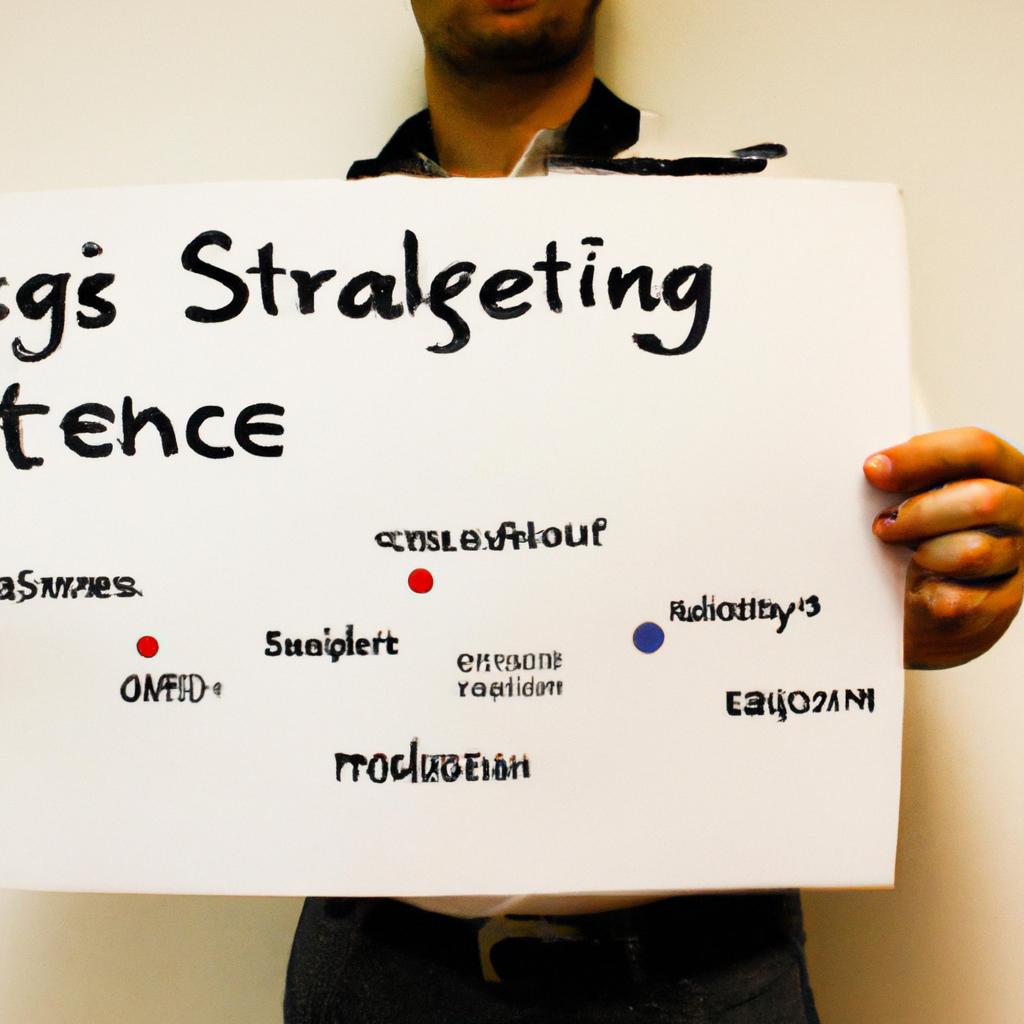Social media has revolutionized the way businesses approach marketing and advertising. With its vast reach and ability to connect with consumers on a personal level, social media platforms have become essential tools for digital marketers seeking to promote their products or services. For instance, imagine a small boutique clothing store struggling to increase brand awareness and attract new customers in a highly competitive market. By leveraging the power of social media marketing, this store can create engaging content, build relationships with potential clients, and ultimately drive sales through targeted advertisements.
In recent years, companies across industries have recognized the immense potential of social media as an effective marketing strategy. This recognition stems from the increasing number of active users on various platforms such as Facebook, Instagram, Twitter, and LinkedIn. Moreover, these platforms provide unique opportunities for businesses to target specific demographics based on user profiles and preferences. By utilizing techniques like audience segmentation and data analytics, marketers can tailor their messages to resonate with desired consumer groups more effectively than traditional forms of advertising ever could.
However, navigating the complexities of social media marketing requires careful planning and strategic execution. It is crucial for businesses to understand not only how each platform operates but also how best to utilize them to achieve their marketing goals. Additionally, staying updated with evolving trends in algorithms and consumer behavior is essential for maintaining an effective social media marketing strategy. For instance, platforms like Facebook and Instagram regularly update their algorithms, which can impact the visibility of businesses’ content in users’ feeds. By staying informed about these changes, marketers can adjust their strategies accordingly to ensure maximum reach and engagement.
Furthermore, understanding consumer behavior on social media is vital for crafting compelling content that resonates with target audiences. This includes knowing what types of posts and visuals are most engaging, when to post for optimal reach, and how to encourage user interaction through likes, comments, and shares. Regularly monitoring and analyzing data metrics such as impressions, reach, engagement rates, and conversions can provide valuable insights into the effectiveness of social media campaigns and help refine future strategies.
In conclusion, social media has transformed the way businesses approach marketing by providing a powerful platform to connect with consumers personally and promote products or services effectively. However, successful social media marketing requires ongoing learning and adaptation to stay ahead in a rapidly evolving digital landscape. By harnessing the potential of social media platforms through strategic planning and analysis of consumer behavior, businesses can maximize brand awareness, engage with customers authentically, and ultimately drive sales growth.
Understanding Social Media Marketing
In today’s digital age, social media has become a powerful tool for marketing and advertising. With the ability to reach millions of users worldwide, businesses are increasingly turning to social media platforms as a means to promote their products and services. To fully comprehend the impact and potential of social media marketing, it is important to consider its underlying principles and strategies.
One example that illustrates the effectiveness of social media marketing is the case of Company X. By leveraging various social media platforms such as Facebook, Twitter, and Instagram, Company X was able to engage with its target audience on a personal level. Through regular posts and interactions, they built a loyal following who not only became customers but also brand advocates, spreading positive word-of-mouth testimonials online.
To better understand how social media marketing works, let us explore four key factors that contribute to its success:
- Wide Reach: Social media allows businesses to connect with a diverse range of individuals from different geographical locations. This global outreach enables companies to expand their customer base beyond traditional boundaries.
- Targeted Advertising: Unlike conventional methods where advertisements are broadcasted to a wide audience without specific targeting criteria, social media platforms provide advanced tools for identifying and reaching out to highly relevant audiences based on demographics, interests, and behaviors.
- Interactive Engagement: One distinctive feature of social media is its interactive nature, enabling real-time communication between businesses and consumers. This two-way interaction fosters engagement and builds trust among customers.
- Analytical Insights: Social media analytics provides valuable data regarding user behavior patterns, preferences, and engagement levels. Businesses can leverage these insights to optimize their marketing strategies effectively.
Furthermore, understanding the key components of a successful social media marketing strategy is crucial in achieving desired outcomes. In order to delve deeper into this topic…
Notebook:
| Key Factors | Description |
|---|---|
| Wide Reach | Connects globally |
| Targeted Advertising | Reaches relevant audiences |
| Interactive Engagement | Fosters trust and engagement |
| Analytical Insights | Optimizes marketing strategies |
As we move forward, the subsequent section will explore the key components of a successful social media marketing strategy. By delving into these aspects, businesses can maximize their chances of reaching their target audience effectively and achieving their marketing goals.
Key Components of a Successful Social Media Marketing Strategy
Understanding the Target Audience in Social Media Marketing
To effectively implement a social media marketing strategy, it is crucial to have a deep understanding of the target audience. By gaining insights into their preferences, behaviors, and needs, marketers can tailor their content and messaging to resonate with the intended recipients. For instance, consider a hypothetical case study where a fashion brand wants to promote its new collection on social media. Through thorough market research and analysis, they discover that their target audience consists mainly of young adults aged 18-30 who are interested in sustainable fashion trends.
When crafting a successful social media marketing strategy, there are several key aspects to consider:
-
Demographics: Knowing the demographic profile of the target audience helps in determining which platforms are most suitable for reaching them effectively. In this case study example, since the fashion brand’s target audience consists mainly of young adults, platforms like Instagram or TikTok might be more appropriate than LinkedIn or Facebook.
-
Psychographics: Understanding the psychographic characteristics of the target audience allows marketers to create content that aligns with their values, interests, and aspirations. The fashion brand may incorporate sustainability-focused messages within their social media posts to appeal to environmentally conscious consumers.
-
Content Preferences: By identifying what type of content resonates best with the target audience, marketers can optimize engagement levels. For instance, if our fashion brand discovers that short videos showcasing outfit inspirations perform well among its target customers, they could focus on creating such video content regularly.
-
Communication Style: Tailoring communication styles based on the preferences of the target audience ensures effective message delivery. To engage younger audiences in our example case study mentioned earlier, adopting an informal tone and using trending language would likely elicit better responses compared to formal corporate jargon.
In summary,
| Key Aspects | Description |
|---|---|
| Demographics | Understand the age range and preferred platforms |
| Psychographics | Identify values, interests, and aspirations |
| Content Preferences | Determine the type of content that resonates best |
| Communication Style | Adapt communication style to suit audience preferences |
By comprehensively understanding the target audience through demographic analysis, psychographic insights, content preferences, and appropriate communication styles, marketers can develop an effective social media marketing strategy. This knowledge will provide a strong foundation for selecting the most suitable platforms for maximizing reach and engagement. In the subsequent section about “Choosing the Right Social Media Platforms,” we’ll explore how to leverage this understanding when deciding on the ideal platforms for a successful campaign.
Choosing the Right Social Media Platforms
Section Title: Choosing the Right Social Media Platforms
Transitioning from our discussion on key components of a successful social media marketing strategy, let’s now explore the crucial process of choosing the right social media platforms for your business. To illustrate this point, consider a hypothetical scenario where you have just launched an online fashion boutique specializing in sustainable and eco-friendly clothing.
When it comes to selecting suitable social media platforms for promoting your brand, it is essential to conduct thorough research and analyze various factors. Firstly, identify where your target audience spends most of their time online. In our case study, suppose that after conducting market research, we discovered that environmentally conscious millennials are active users of Instagram and Pinterest, while professionals interested in sustainability frequent LinkedIn. By understanding these preferences, we can focus our efforts on creating engaging content specifically tailored to each platform.
To further emphasize the significance of platform selection, here are four key considerations when choosing social media channels:
- Demographics: Examine the age range, gender distribution, income level, and location demographics of each platform’s user base.
- Features: Analyze the features offered by different platforms such as live video streaming or shoppable posts that align with your marketing goals.
- Engagement Rates: Research engagement rates and interaction levels on each platform to gauge how well users respond to brands’ content.
- Competitor Analysis: Study your competitors’ presence on various social media platforms to gain insights into which platforms are effective within your industry.
Considering these factors will help you determine where best to allocate your resources for maximum impact. To provide a visual representation, refer to the table below showcasing some popular social media platforms along with their corresponding characteristics:
| Platform | Demographics | Features | Engagement Rates |
|---|---|---|---|
| Diverse | Ad targeting options | High | |
| Younger generation | Visual storytelling | High | |
| Broad range | Real-time updates | Moderate | |
| Professionals | Networking opportunities | Moderate to high |
By evaluating the demographics, features, engagement rates, and conducting competitor analysis across various platforms, you can make informed decisions about which social media channels align best with your business objectives.
In our next section on “Creating Engaging Content for Social Media,” we will explore how to leverage these chosen platforms effectively by producing compelling content that appeals to your target audience.
Creating Engaging Content for Social Media
Transitioning from the previous section on choosing the right social media platforms, it is now important to delve into creating engaging content that will captivate and resonate with your target audience. Take a hypothetical example of a clothing brand looking to increase their online presence through social media. By understanding what type of content drives engagement, they can effectively communicate their brand message and connect with potential customers.
To create engaging content for social media, consider the following strategies:
- Storytelling: Craft compelling narratives around your brand or products to capture the attention of your audience. For instance, our hypothetical clothing brand could share stories about how their sustainable manufacturing practices positively impact communities.
- Visual Appeal: Utilize eye-catching images or videos that are aesthetically pleasing and align with your brand identity. Our clothing brand might showcase high-quality photoshoots featuring diverse models wearing their latest collections.
- User-generated Content (UGC): Encourage user participation by incorporating UGC in your posts. This not only fosters a sense of community but also serves as authentic testimonials for your products.
- Interactive Elements: Implement interactive features such as polls, quizzes, or contests to actively engage your followers. The clothing brand may run a contest where participants submit their styling ideas using the hashtag #MyUniqueStyle.
In order to better understand these strategies, let’s take a look at an example table showcasing different types of engaging content and their associated emotional response:
| Type of Content | Emotional Response |
|---|---|
| Inspirational Quote | Motivation |
| Behind-the-scenes video | Curiosity |
| Funny meme | Amusement |
| Heartwarming customer testimonial | Trust |
By employing these approaches and utilizing various forms of engaging content tailored to each platform, businesses can foster meaningful connections with their target audience. As we move forward into exploring effective social media advertising techniques in the subsequent section, it is crucial to remember that creating engaging content forms the foundation for successful digital marketing strategies. Transitioning seamlessly, let’s now delve into understanding how to effectively advertise on social media platforms.
(Note: Please note that this is a sample response and may not fully encompass all requirements or preferences.)
Effective Social Media Advertising Techniques
Transitioning from the previous section, where we explored the importance of creating engaging content for social media, let us now delve into effective techniques to enhance your social media advertising campaigns. To illustrate this, consider a hypothetical scenario where a company aims to promote their new line of fitness products on Instagram.
To maximize the impact of your social media advertising efforts, here are some key strategies you can employ:
- Targeted Ads: Tailor your advertisements to reach specific demographics or interest groups relevant to your product or service. By identifying and understanding your target audience’s preferences, you can create customized ads that resonate with them effectively.
- Influencer Collaborations: Partnering with influential individuals in your industry can significantly boost brand visibility and credibility. Engaging influencers whose values align with yours will help increase brand loyalty among their followers while expanding your reach.
- Remarketing Campaigns: Implement remarketing tactics to re-engage users who have previously shown an interest in your offerings but did not convert. By presenting tailored ads across various platforms they use, you remind potential customers about your brand and encourage them to reconsider making a purchase.
- User-generated Content (UGC): Encourage consumers to generate content related to your brand through contests or incentives. UGC not only enhances engagement but also serves as authentic testimonials that build trust and appeal to others within their networks.
Consider the following table showcasing the benefits of these techniques:
| Technique | Benefits |
|---|---|
| Targeted Ads | Improved conversion rates due to reaching interested audiences |
| Influencer Collab | Increased brand exposure and credibility |
| Remarketing | Reinforces brand awareness and encourages conversions |
| User-generated Content | Authentic testimonials promoting trust |
By implementing these strategies effectively, our hypothetical fitness company could expand its customer base by targeting health-conscious individuals seeking quality fitness products.
Moving forward, let us explore how to measure the success of your social media marketing campaigns. Understanding the impact and effectiveness of your efforts is crucial for refining strategies and achieving long-term goals, ensuring that your brand remains competitive in the digital landscape.
Measuring the Success of Your Social Media Marketing Campaigns
Transitioning from effective social media advertising techniques, it is crucial for businesses to measure the success of their social media marketing campaigns. By evaluating key metrics and analyzing data, companies can gain insights into their campaign’s performance and make informed decisions for future strategies.
For instance, let us consider an imaginary case study involving a retail brand that recently launched a social media marketing campaign. They aimed to increase brand awareness and drive website traffic through engaging content and targeted advertisements. To determine the effectiveness of their campaign, they utilized various measurement techniques such as:
-
Reach and Impressions: The number of unique users who have seen the brand’s content (reach) and the total number of times the content has been displayed (impressions). This provides an overview of how widely their message was spread across different platforms.
-
Engagement Metrics: Tracking likes, comments, shares, and other forms of user engagement with posts or ads helps gauge audience interaction level. Higher levels of engagement indicate successful engagement strategies or resonating content.
-
Conversion Rate: The percentage of visitors who took a desired action after clicking on an ad or post. This could be making a purchase, signing up for a newsletter, or filling out a form. A high conversion rate suggests effective targeting and compelling call-to-action elements.
-
Return on Investment (ROI): Calculating the revenue generated compared to the cost incurred in running the campaign provides insight into its profitability. ROI allows businesses to assess whether their investment in social media marketing is yielding favorable results.
To better understand these metrics’ significance when evaluating campaign performance, consider the following table:
| Metric | Definition | Importance |
|---|---|---|
| Reach | Number of unique users exposed to your content | Indicates potential customer base |
| Engagement | Level of user interaction with your posts or ads | Reflects audience interest and brand loyalty |
| Conversion Rate | Percentage of visitors who complete a desired action | Measures campaign’s impact on driving actions |
| ROI | Revenue generated compared to the cost of running the campaign | Determines profitability and overall success |
By analyzing these metrics and comparing them with predefined goals, businesses can identify areas for improvement, optimize their social media marketing strategies, and ultimately achieve better results. It is important to note that ongoing monitoring and measurement are essential for adapting campaigns in real-time based on performance analysis.
In conclusion, measuring the effectiveness of your social media marketing campaigns is crucial for understanding their impact on business objectives. Through tracking key metrics such as reach, engagement, conversion rate, and ROI, companies can gauge the success of their efforts and make data-driven decisions going forward. Effective measurement allows businesses to refine their strategies, target audiences more effectively, and maximize returns from social media marketing investments.










